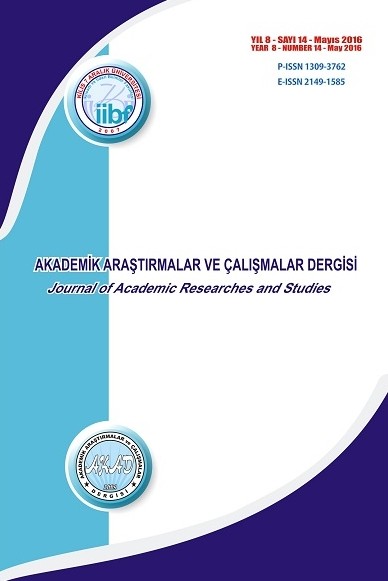İÇSEL PARA TEORİSİ VE JOAN ROBINSON
İçsel para, Post Keynesyen iktisadın en önemli kavramlarından biridir. Post Keynesyen içsel para teorisi, banka kredilerinin para arzını belirlemedeki önemine vurgu yapmaktadır. Ancak içsel para, Post Keynesyenlerin kendi aralarında anlaşmazlığa düşmesine de yol açmaktadır. Uyumcu ve yapısalcı olarak adlandırılan yaklaşımlar, özellikle kredi tabanlı para arzı eğrisinin eğimi konusunda fikir ayrılığı yaşamaktadırlar. Joan Robinson, Post Keynesyen literatüre eserleriyle büyük katkılar veren iktisatçılardan biridir. Ancak para teorisine yaptığı katkılar tartışmalıdır. Bir görüş onun çalışmalarını içsel para yaklaşımının ilk örneklerinden sayarken, bir başka görüş paraya hiçbir zaman yeterli ilgi göstermediğini ileri sürmektedir.
Anahtar Kelimeler:
Post Keynesyen, İçsel Para, Uyumcu Yaklaşım, Yapısalcı Yaklaşım
___
- ARESTIS, P. ve HOWELLS, P. (1996). Theoretical Reflections on Endogenous Money: The Problem with Convenience Lending, Cambridge Journal of Economics, 20: 539-551.
- CHICK, V.ve DOW, S. (2002). Monetary Policy with Endogenous Money and Liquidty Preference: A Nondualistic Treatment, Journal of Post Keynesian Economics, 24(4): 587-607.
- DILLARD, D. (1989). “The paradox of money in the economics of Joan Robinson”, (Ed.)Feiwel, G. R., The Economics of Imperfect Competition and Employment: Joan Robinson and Beyond, Macmillan, London
- DOW, S. (2006). Endogenous Money: Structuralist, P. Arestis & M. Sawyer (Eds) A Handbook of Alternative Monetary Economics, Edward Elgar
- FONTANA, G. (2011). “Bringing Together the Horizontalist and Structuralist Analyses of Endogenous Money”, (Ed.) Arestis, P., Microeconomics, Macroecenomics and Economic Policy, Palgrave Macmillan
- FONTANA, G. (2003). Post Keynasian Approaches to Endogenous Money: A Time Framework Explanation, Review of Political Economy, 15(3): 291-314,
- FOSTER, G. P. (1986). The Endogeneity of Money and Keynes’s General Theory, Journal of Economic Issues, 20(4): 953-968
- GNOS, G. ve ROCHON, L.P. (2003). Joan Robinson and Keynes: Finance, Relative Prices and the Monetary Circuit, Review of Political Economy, 15(4): 483-491
- GRAZIANI, A. (1989). “Money and Finance in Joan Robinson’s Works”, (Ed.) Feiwel, G. R., The Economics of Imperfect Competition and Employment: Joan Robinson and Beyond, Macmillan, London
- KALDOR, N. (1970). The New Monetarism, Lloyds Bank Review, July, 1-17
- KALDOR, N. (1960). The Radcliffe Report, The Review of Economics and Statistics, 42(1): 14-19
- LAVOIE, M. (2006a). Introduction to Post-Keynesian Economics, Palgrave Macmillan, New York
- LAVOIE, M. (2006b). “Endogenous Money: Accommodationist”, (Ed.) Arestis, P ve Sawyer , M., A Handbook of Alternative Monetary Economics, Edward Elgar
- LAVOIE, M. (1999). The Credit-led Supply of Deposits and the Demand for Money: Kaldor’s Reflux Mechanism as Previously Endorsed by Joan Robinson, Cambridge Journal of Economics, 23(1): 103-113
- LAVOIE, M. (1996). Horizontalism, Structuralism, Liquidity Preference and the Principle of Increasing Risk, Scottish Journal of Political Economy, 43(3): 275-300
- LAVOIE, M. (1991). “Change, Continuity and Originality in Kaldor’s Monetary Theory”, (Ed.) Nell, E. ve Semmler, W., Nicholas Kaldor and Mainstream Economics: Confrontation or Convergences?, St. Martin’s Press, New York
- MINSKY, H. (1957a). Central Banking and Money Market Changes, The Quarterly Journal of Economics, 71(2): 171-187
- MINSKY, H. (1957b). Monetary Systems and Accelerator Models, The American Economic Review, 47(6): 859-883
- MOORE, B J. (1998). Accommodation to Accommodationism: A Note, Journal of Post Keynesian Economics, 21(1): 175-178
- MOORE, B. J. (1991a). “Marx, Keynes, Kalecki and Kaldor on the Rate of Interest as a Monetary Phenomenon”, (Ed.) Nell, E. ve Semmler, W., Nicholas Kaldor and Mainstream Economics: Confrontation or Convergences?, St. Martin’s Press, New York
- MOORE, B. J. (1991b). Has the Demand for Money Mislaid? A Reply to “Has Moore Become too Horizontal?”, Journal of Post Keynesian Economics, 14(1): 125-133
- MOORE, B. J. (1988). Horizontalists and Verticalists: The Macroeconomics of Credit Money, Cambridge University Press
- MOORE, B. J. (1984). Contemporaneous Reserve Accounting: Can Reserve Be Quantity-Constrained?, Journal of Post Keynesian Economics, 7(1): 103-113
- NELL, E. J. (2005). “Money in The Accumulation of Capital”, (Ed.) Gibson, B., Joan Robinson’s Economics, Edward Elgar
- ÖZGÜR, G. (2008). İçsel Para Teorisine Genel Bir Bakış, Hacettepe Üniversitesi İktisadi ve İdari Bilimler Fakültesi Dergisi, 26(2): 51-79
- PALLEY, T. I. (1996). Accommodationism versus Structuralism: Time for an Accommodation, Journal of Post Keynesian Economics, 18(4): 585-594
- PARGUEZ, A. (2005). “An Inquiry into a Dark Mystery in the History of the Monetary Theory of Production: What Went Wrong with the Early Contribution of Joan Robinson”, (Ed.) Fontana G. ve Realfonzo R., The Monetary Theory of Production. Palgrave Macmillan, London
- POLLIN, R. (1991). Two Theories of Money Supply Endogeneity: Some Empirical Evidence, Journal of Post Keynasian Economics, 13(3): 366-396
- ROBINSON, J. (1978). Contributions to Modern Economics, Academic Press
- ROBINSON, J. (1970). Quantity Theories Old and New: Comment, Journal of Money, Credit and Banking, 2(4): 504-512
- ROBINSON, J. (1969). Introduction to the Theory of Employment, Palgrave Macmillan, London
- ROBINSON, J. (1956). The Accumulation of Capital, Richard D. Irwin, Illinois
- ROCHON, L. P. (2005). “Robinson on Credit, Money and Finance”, (Ed.) Gibson, B., Joan Robinson’s Economics, Edward Elgar
- ROCHON, L.P. (2001a). Cambridge's Contribution to Endogenous Money: Robinson and Kahn on Credit and Money, Review of Political Economy, 13(3): 287-307
- ROCHON, L. P. (2001b). “Horizontalism: Setting the Record Straight”, (Ed. Rochon, L. P. Ve Vernengo, M., Credit, Interest Rates and the Open Economy, Edward Elgar
- VERNENGO, M. ve ROCHON, L.P. (2001). Kaldor and Robinson on Money and Growth, European Journal of the History of Economic Thought, 8(1) 75-103
- WRAY, L.R. (1990). Money and Credit in Capitalist Economies: The Endogenous Money Approach, Edward Elgar
- ISSN: 1309-3762
- Yayın Aralığı: Yılda 2 Sayı
- Başlangıç: 2009
- Yayıncı: Kilis 7 Aralık Üniversitesi
Sayıdaki Diğer Makaleler
KIBRIS SORUNUNA İLİŞKİN ALGILAMANIN KKTC NÜFUS DİNAMİĞİ İÇİNDE DEĞERLENDİRİLMESİ
İÇSEL PARA TEORİSİ VE JOAN ROBINSON
TÜRKİYE’NİN EKSENİ KAYIYOR MU? BİR LİTERATÜR DEĞERLENDİRMESİ
Ali BALCI, Filiz Cicioğlu, Dilek KÜÇÜKBOZ
ÇİN’İN MERKANTİLİST ENERJİ POLİTİKALARI VE LATİN AMERİKA’DAKİ YANSIMALARI
EBEVEYNLERİN ÖZEL KREŞ VE ANAOKULU TERCİHİNE YÖNELİK TUTUMLARININ KONJOİNT ANALİZİ İLE İNCELENMESİ
SOSYAL HAREKETLER ve SİYASAL PARTİLER
AYDIN SANCAĞI TİRE KAZASINDA BULUNAN VAKIFLARIN 1275 (H.) TARİHLİ MUHASEBE DEFTERİ
BİLGİ YÖNETİM YETENEĞİ VE GİRİŞİMCİLİK STRATEJİSİ GELİŞTİRME YETENEĞİ ARASINDAKİ İLİŞKİ
